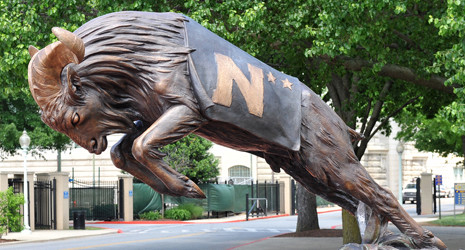Facts About Navy Bill
Navy Bill, the cherished sculpture of the United States Naval Academy's mascot, Bill the Goat, boasts a rich history that dates back to the mid-20th century. Designed by Clemente Spampinato in 1956, the bronze sculpture was gifted to the Academy in 1957. For decades, it proudly stood inside Gate 1 of the Academy, until it was temporarily removed for restoration in 2010. Thanks to the generosity of the Class of 1965, Navy Bill was refurbished and returned to its original location. Furthermore, in 2015, the same class commissioned another statue, which now graces the north end zone of the Navy–Marine Corps Memorial Stadium.
The sculpture itself is particularly striking, depicting a large bronze billy goat in a charging stance atop a stone base. On its side, you’ll find a varsity letter "N" and two stars, symbolizing victories over West Point in the Army-Navy games. The granite base measures 48 by 30 by 86 inches, while the bronze sculpture stands at 50 by 27 by 87 inches. In 2015, sculptor Tony Thamasangvarn and the Baltimore New Arts Foundry led a refurbishment project, incorporating new elements contributed by the Class of 1965.
Inscriptions on the sculpture include the artist's name and the foundry, along with a plaque that details the history of the Navy mascot. While the legend of Navy Bill dates back to 1890, the first recorded use of a live goat as the Academy's mascot was in 1893. Over the years, Navy Bill has become more than just a statue; it serves as the inspiration for the Academy's sports logo and holds a special place in the hearts of many.
Whether you see it at Gate 1 or in the stadium, Navy Bill stands as a proud emblem of the Naval Academy's spirit and tradition.

 Mexico
Mexico